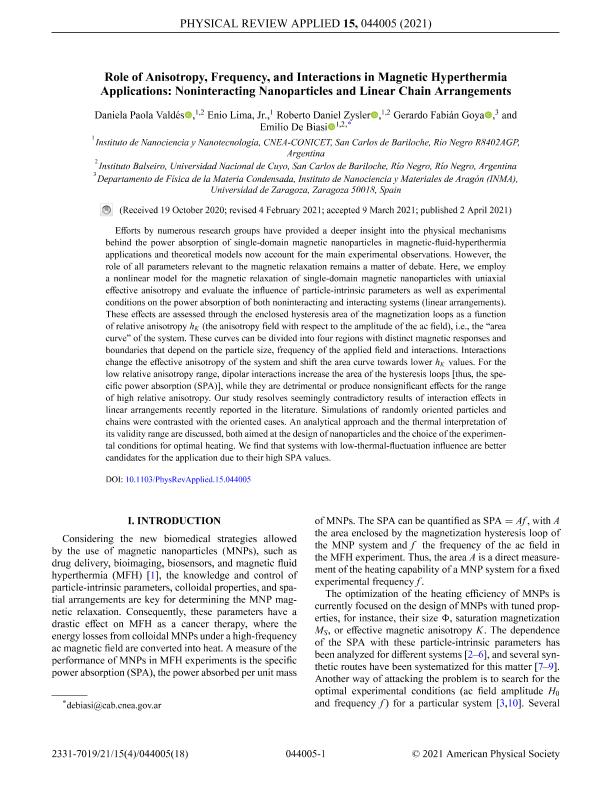Mostrar el registro sencillo del ítem
dc.contributor.author
Valdés, Daniela Paola

dc.contributor.author
Lima, Enio Junior

dc.contributor.author
Zysler, Roberto Daniel

dc.contributor.author
Goya, Gerardo Fabián
dc.contributor.author
de Biasi, Emilio

dc.date.available
2022-12-19T17:22:14Z
dc.date.issued
2021-04
dc.identifier.citation
Valdés, Daniela Paola; Lima, Enio Junior; Zysler, Roberto Daniel; Goya, Gerardo Fabián; de Biasi, Emilio; Role of Anisotropy, Frequency, and Interactions in Magnetic Hyperthermia Applications: Noninteracting Nanoparticles and Linear Chain Arrangements; American Physical Society; Physical Review Applied; 15; 4; 4-2021; 1-18
dc.identifier.issn
2331-7019
dc.identifier.uri
http://hdl.handle.net/11336/181799
dc.description.abstract
Efforts by numerous research groups have provided a deeper insight into the physical mechanisms behind the power absorption of single-domain magnetic nanoparticles in magnetic-fluid-hyperthermia applications and theoretical models now account for the main experimental observations. However, the role of all parameters relevant to the magnetic relaxation remains a matter of debate. Here, we employ a nonlinear model for the magnetic relaxation of single-domain magnetic nanoparticles with uniaxial effective anisotropy and evaluate the influence of particle-intrinsic parameters as well as experimental conditions on the power absorption of both noninteracting and interacting systems (linear arrangements). These effects are assessed through the enclosed hysteresis area of the magnetization loops as a function of relative anisotropy hK (the anisotropy field with respect to the amplitude of the ac field), i.e., the "area curve"of the system. These curves can be divided into four regions with distinct magnetic responses and boundaries that depend on the particle size, frequency of the applied field and interactions. Interactions change the effective anisotropy of the system and shift the area curve towards lower hK values. For the low relative anisotropy range, dipolar interactions increase the area of the hysteresis loops [thus, the specific power absorption (SPA)], while they are detrimental or produce nonsignificant effects for the range of high relative anisotropy. Our study resolves seemingly contradictory results of interaction effects in linear arrangements recently reported in the literature. Simulations of randomly oriented particles and chains were contrasted with the oriented cases. An analytical approach and the thermal interpretation of its validity range are discussed, both aimed at the design of nanoparticles and the choice of the experimental conditions for optimal heating. We find that systems with low-thermal-fluctuation influence are better candidates for the application due to their high SPA values.
dc.format
application/pdf
dc.language.iso
eng
dc.publisher
American Physical Society

dc.rights
info:eu-repo/semantics/openAccess
dc.rights.uri
https://creativecommons.org/licenses/by-nc-sa/2.5/ar/
dc.subject
hyphertermia
dc.subject
nanoparticles
dc.subject
magnetic interactions
dc.subject.classification
Física de los Materiales Condensados

dc.subject.classification
Ciencias Físicas

dc.subject.classification
CIENCIAS NATURALES Y EXACTAS

dc.title
Role of Anisotropy, Frequency, and Interactions in Magnetic Hyperthermia Applications: Noninteracting Nanoparticles and Linear Chain Arrangements
dc.type
info:eu-repo/semantics/article
dc.type
info:ar-repo/semantics/artículo
dc.type
info:eu-repo/semantics/publishedVersion
dc.date.updated
2022-10-04T14:44:12Z
dc.journal.volume
15
dc.journal.number
4
dc.journal.pagination
1-18
dc.journal.pais
Estados Unidos

dc.description.fil
Fil: Valdés, Daniela Paola. Consejo Nacional de Investigaciones Científicas y Técnicas. Oficina de Coordinación Administrativa Ciudad Universitaria. Unidad Ejecutora Instituto de Nanociencia y Nanotecnología. Unidad Ejecutora Instituto de Nanociencia y Nanotecnología - Nodo Bariloche | Comisión Nacional de Energía Atómica. Unidad Ejecutora Instituto de Nanociencia y Nanotecnología. Unidad Ejecutora Instituto de Nanociencia y Nanotecnología - Nodo Bariloche; Argentina
dc.description.fil
Fil: Lima, Enio Junior. Consejo Nacional de Investigaciones Científicas y Técnicas. Oficina de Coordinación Administrativa Ciudad Universitaria. Unidad Ejecutora Instituto de Nanociencia y Nanotecnología. Unidad Ejecutora Instituto de Nanociencia y Nanotecnología - Nodo Bariloche | Comisión Nacional de Energía Atómica. Unidad Ejecutora Instituto de Nanociencia y Nanotecnología. Unidad Ejecutora Instituto de Nanociencia y Nanotecnología - Nodo Bariloche; Argentina
dc.description.fil
Fil: Zysler, Roberto Daniel. Consejo Nacional de Investigaciones Científicas y Técnicas. Oficina de Coordinación Administrativa Ciudad Universitaria. Unidad Ejecutora Instituto de Nanociencia y Nanotecnología. Unidad Ejecutora Instituto de Nanociencia y Nanotecnología - Nodo Bariloche | Comisión Nacional de Energía Atómica. Unidad Ejecutora Instituto de Nanociencia y Nanotecnología. Unidad Ejecutora Instituto de Nanociencia y Nanotecnología - Nodo Bariloche; Argentina
dc.description.fil
Fil: Goya, Gerardo Fabián. Universidad de Zaragoza; España
dc.description.fil
Fil: de Biasi, Emilio. Consejo Nacional de Investigaciones Científicas y Técnicas. Oficina de Coordinación Administrativa Ciudad Universitaria. Unidad Ejecutora Instituto de Nanociencia y Nanotecnología. Unidad Ejecutora Instituto de Nanociencia y Nanotecnología - Nodo Bariloche | Comisión Nacional de Energía Atómica. Unidad Ejecutora Instituto de Nanociencia y Nanotecnología. Unidad Ejecutora Instituto de Nanociencia y Nanotecnología - Nodo Bariloche; Argentina
dc.journal.title
Physical Review Applied
dc.relation.alternativeid
info:eu-repo/semantics/altIdentifier/url/https://link.aps.org/doi/10.1103/PhysRevApplied.15.044005
dc.relation.alternativeid
info:eu-repo/semantics/altIdentifier/doi/http://dx.doi.org/10.1103/PhysRevApplied.15.044005
Archivos asociados
